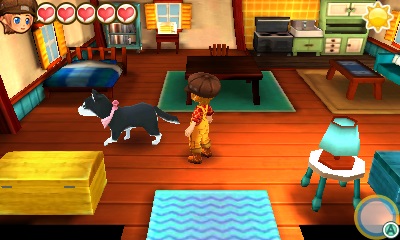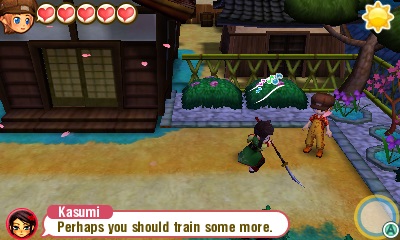Review by Clark A.
If each entry could be reduced to a subset of feature lists, of course, the franchise would arguably not be so prolific. I’ve long surmised the chief reason for its longevity comes down to each game’s own atmosphere. This is to say the cosiness evoked by the town the player inhabits, the folks the player interacts with, and the presentation are might be as crucial to sticking around as tasks and goals themselves. Said elements provide a framework in which carrying out mundane missions can transcend busywork to become genuinely appealing. It does become trickier to discuss the merits of each game’s world compared to “game X had cooler horses”, but it’s probably a more remarkable discussion.
Before even tackling these areas, however, Trio of Towns labours to elicit passion from players and give them a stake in their avatar’s proceedings. Most Harvest Moon titles are content kicking off the opening minutes by handing an unproven farmer a plot of land due to inheritance or obligation. That works fine as a minimalist introduction, especially to a system where the player calls the shots. This title, however, opens with a heated quarrel between a business-minded father and his head-in-the-clouds offspring about whether he or she can hack it as a farmer. This serves as a launch pad for a greater coming of age story wherein the protagonist must prove themselves by learning the ropes of farming.
However mundane a couple of the chores may be, they’re quick and painless at the worst of times. I would go as far as to say these jobs are the driving feature of this particular Story of Seasons entry because they tie each town together into one world; clients from one town may ask you to help someone in another. Furthermore, completing several tasks in one town increases its ranking, which in turn enhances the town’s physical appearance, features, and stock of items. They’re not as financially dependable as the time-honoured selling of crops, milking cows, and mining for ores, but they serve an overarching purpose and occasionally provide nifty rewards such as a Mario costume. Operating in conjunction with the story, your father also provides a list of deeds he feels will test your prowess as a farmer. These are fundamentally similar to the part-time jobs but tend to be issued with the long-term in mind rather than one day deadlines.
 The result is informative and enlightening, but thankfully not always rammed down the throat either. Similarly, the way these regions interact is fascinating to observe firsthand. The three radically different societies exist in close proximity but ultimately complement and rely on each other. Each town has enough core resources to sustain itself; the likes of livestock, crops, and restaurants are not exclusive to any town in particular. Even so, conventions like mining have been reallocated into towns that are more thematically appropriate and so there are exclusive commodities (see: reasons for people to visit each town on a whim). Citizens do naturally gravitate toward their own community with regards to food preferences and friend circles, but foreign relations are booming and courteous.
The result is informative and enlightening, but thankfully not always rammed down the throat either. Similarly, the way these regions interact is fascinating to observe firsthand. The three radically different societies exist in close proximity but ultimately complement and rely on each other. Each town has enough core resources to sustain itself; the likes of livestock, crops, and restaurants are not exclusive to any town in particular. Even so, conventions like mining have been reallocated into towns that are more thematically appropriate and so there are exclusive commodities (see: reasons for people to visit each town on a whim). Citizens do naturally gravitate toward their own community with regards to food preferences and friend circles, but foreign relations are booming and courteous.Because there are three fully-featured towns here, there obviously must be quite a few residents to fill them. Yet despite having an enormous cast of characters spread out across the game’s world, just about everyone has stories, goals, and personality traits. The former two tend not to be spelled out explicitly, so talking to villagers each day and viewing the wealth of cutscenes is more enthralling than ever. Some folks are recovering from tragic loss, some are lively pranksters looking to grow up, some are obsessed with sweets due to childhood illness. They maintain relationships with numerous other characters complex enough to warrant an elaborate chart, which you can gradually observe during their daily routines. As a side note, the bulky cast means there’s more birthdays and festivals than ever. The point here is each resident has texture and this works miracles in bringing an already exciting world to life.
– Clark A.
Anime Editor











